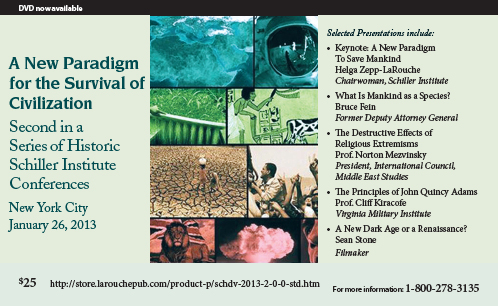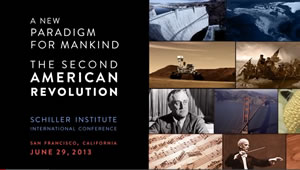 |
NEW WEBSITE: FORUM FOR A NEW PARADIGM
The Sense Un-Certainty Of Truth
by Megan Beets
June 2013
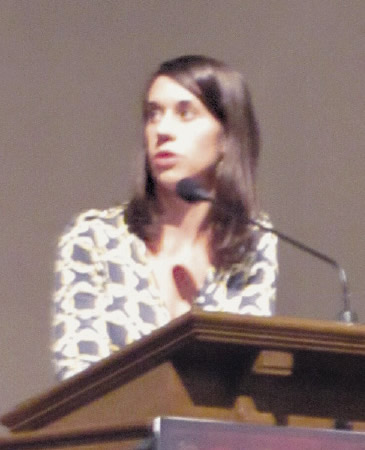 EIRNS/Daniel Platt
Megan Beets: “The human species, as opposed to animal species, which are fixed, is a species of perpetual progress.”
|
Megan Beets, of the LaRouche Basement Science Team, gave this presentation at the June 29 San Francisco Schiller Conference, “A New Paradigm for Mankind: The Second American Revolution,” on the final panel, titled “The Role of Creativity in Development.” Previous coverage of the conference can be found in EIR, July 12, July 19, July 26, and Aug. 2, 2013.
What I’d like to do tonight is something which is actually pretty difficult, and impossible in a certain sense, and which, by its nature, will fall short—especially in light of what we opened tonight’s panel with [a performance of Mozart’s “Dissonance Quartet,” by the Schiller Institute Dirichlet Quartet]—which is that I would take a few minutes to try to talk about the creative process of the human mind.
And the reason I set myself this task is because I think it really goes to the heart of what has been the theme of today’s conference, throughout every presentation and every panel, at least implicitly, which is the fact that the human species, as opposed to animal species, which are fixed, mankind is a species of perpetual progress. Mankind has the capacity to constantly and perpetually increase the territory that he inhabits and controls; to perpetually increase the scope of the resources at his fingertips; to constantly increase the consumption of resources and the power that he exerts over them; and to expand, perpetually, out into the Solar System, and into the Universe.
Not only does man have this as a potential, as an ability, but this is his nature. This is what makes us human. This is what we’re supposed to do.
And one of the reasons you know that this is what we’re supposed to do, is that it’s what makes us happy. That’s what actually creates a happy, successful society. And we’ve seen that at moments in American history—under FDR, under Lincoln, when we landed on the Moon under JFK.
Now what I want to get at tonight is how this was accomplished. And on one level, it’s very straightforward. This is accomplished because, as opposed to animals, human beings have a capacity to come to discover valid, universal principles of the universe, principles which are governing the unfolding of processes around us on the planet, processes occurring in the Solar System, out into the galaxy, and hopefully beyond. Man can intuit the presence of these principles. Man can come to know so precisely the nature of these principles, that he can wield them in the form of new technologies that he creates, new forms of organization of his society, new forms of behavior of the species via new actions through economic systems. The universe rewards mankind which does this, with an increased power to continue making discoveries, and to continue expanding his dominion.
But what I want to zero in on is how is it that the human being comes to detect, to know, a principle.
The Fallacy of Sense-Perception
Now it was referenced earlier by Helga LaRouche, the fact that today we live in a terrible, terrible culture, one dominated by pleasure, one dominated by experiences of the senses. The issue is that most people in society believe that you come to know anything because you sense it; because you see it; because you touch it. So today, to most people alive today, what the senses give you of reality, is the most substantial, is the most basic, is the most stable.
Now this isn’t true. And I think most of you, hopefully, realize that.
What I want to do, sort of for fun, but also because I think it reinforces the point, is, I want to show you an image (Figure 1).
|
FIGURE 1 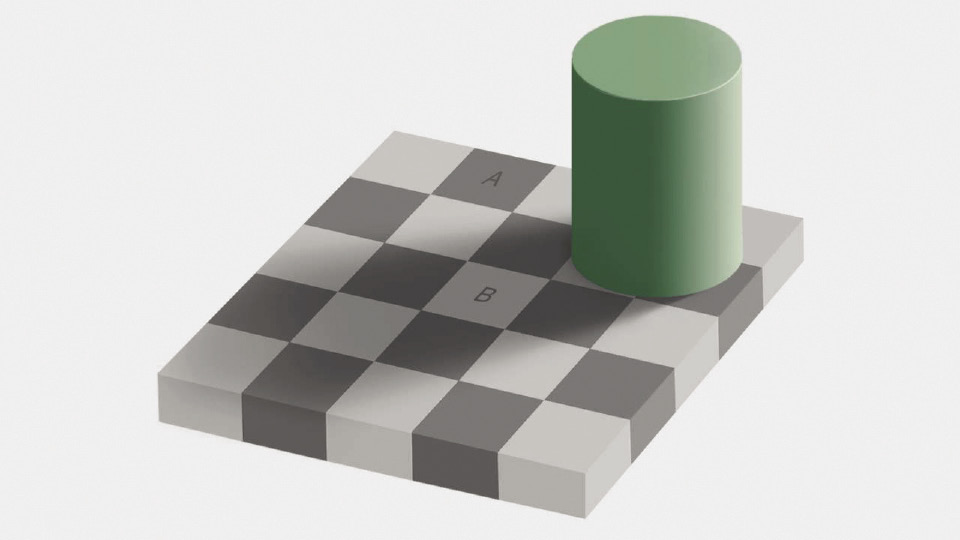 LPAC
|
So, two of these squares are labeled with letters. One of them is labeled B, which is just to the left of the cylinder. The other one is labeled A, which is the second in from the left on the top.
So, you have a checkerboard, dark squares, and light squares. A is a dark square, and B is a light square, correct?
What if I told you that square A and square B were actually the exact same shade of gray?
Can we get the second image (Figure 2)?
|
FIGURE 2 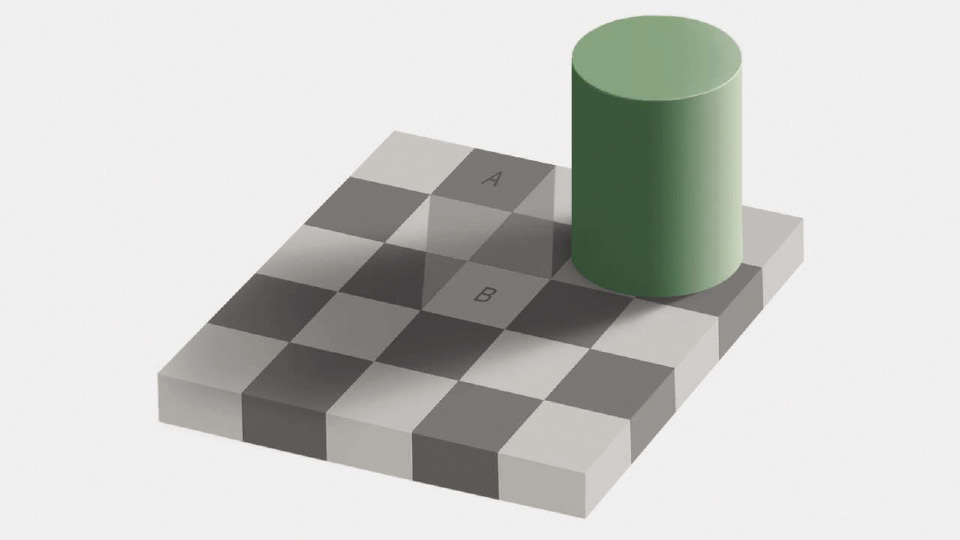 LPAC
|
Flip back and forth a couple of times.
So you can see, when I join them (Figure 3), that there’s actually no difference—but there clearly is a difference.
|
FIGURE 3 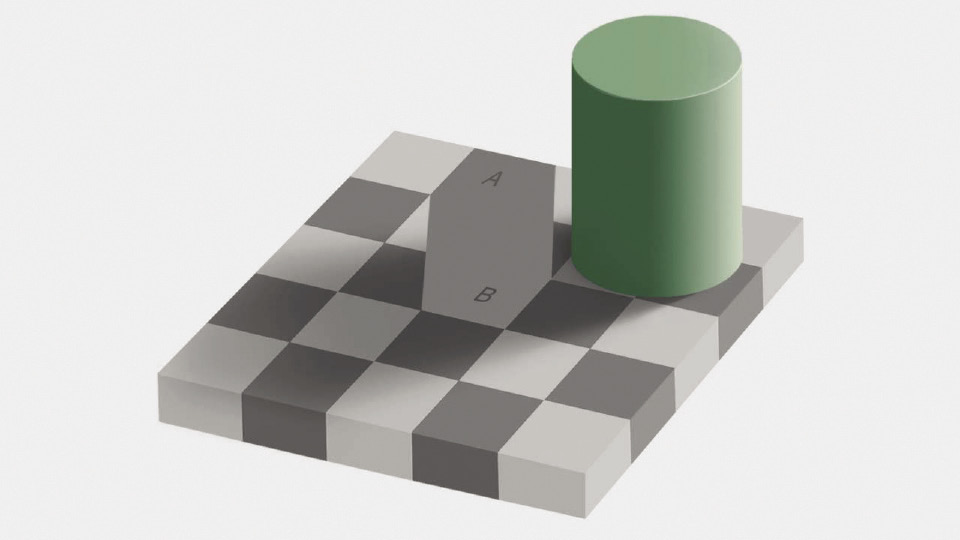 LPAC
|
So I wanted to use this, not because it gives the final word on the fallacy of sense perception, but I think it’s enough to provoke the point, that there’s nothing at all self-evident about what you perceive with the senses. Actually, what you perceive with the senses is probably the most unstable, and most unreliable, thing about you.
Kepler’s ‘Harmony’
I want to offer two examples, which are really examples of the same thing, to open up for you what is man’s sense for truth, and how does he experience principle.
The first example I want to give is Johannes Kepler. Now Kepler, in 1619, publishes one of the most important scientific treatises to date, which is titled The Harmony of the World.1 Now, just to put it in context, 1619 is right after the beginning of the Thirty Years War, which is the end of over 100 years of religious war that destroyed Europe, out of which comes the Treaty of Westphalia [1648].
Harmony of the World is his exposition of the completion of his discovery of universal gravitation, which he had first published ten years earlier, in 1609, in his work The New Astronomy.
The significant thing that I want to raise about what Kepler presents in the Harmony of the World, is the way in which he comes to this discovery. What’s presented in this work is actually something completely astounding. To the Sun—which, as Kepler proved ten years earlier, was the physical mover of the planets and the Solar System, exerting a physical power over the motions of the planets—to the Sun, gazing out at the motion of the set of planets in the Solar System, the fastest and the slowest motions of the set of planets orbiting around the Sun, assume motions which are in the same ratio to each other as the strings [on a musical instrument], which would produce the major musical scale, and the minor musical scale.
In other words, the motions of the planets perfectly fit the musical system that human beings had developed to express their ideas.2 There is a scale in the Solar System. Almost.
If you take the ratios of the motions of the planets, they’re actually not exactly mathematically precise, precisely the same as the ratios which give you the musical scale, the notes of the musical scale. Now, how does Kepler solve this?
The way he solves it is by taking his tables of observations, and rather than reworking the data, or trying to come up with some new kind of theory, he actually takes the tables of data and he closes them. And he puts them to one side.
So, where does he go to seek reality? He goes to the imagination. He imagines that he is the Creator of the Solar System, and he imagines, were he the Sun, the cause of the multiplicity of motions unfolding around him, how would he fix the motions of this set of planets, such that at every moment, each motion is in harmony with every other motion, as much as possible, and that every one of these multiple motions is an expression of one single idea of the Sun.
And so what he does, is he takes the musical scale, assigns the notes of the musical scale to the different planets, and then he begins adjusting them, to fulfill these criteria. And so he makes one planet go a little bit faster, or one planet a little bit slower, so that there’s the greatest coherence among all the parts.
He then forms, from his imagination, a table of what the motions of the planets should be, according to his idea. Then he finally takes out his tables of actual observations again, and he finds that they are absolutely precise. And what he created in his imagination, and according to the convictions he had about Beauty, about Harmony, ideas he had gained from the musical culture around him, of the developing music of polyphony, he comes up with a system that never could have been derived from any kind of mathematics, and yet which so precisely fit the planets, that this unleashed complete pandemonium among the oligarchy.
How Does a String Quartet Work?
What I want people to consider is, how did Kepler make his discovery? It was through nothing that he sensed, but it was only through feeling out a process of creation.
So, with that idea, what I’d now like you to consider is what you experienced at the opening of the panel, which is Classical music. And I want you to consider, among many, many things that we could attempt to say about Classical music, is the process of a string quartet, or another ensemble.
A string quartet is actually presented with the exact same challenge as a scientist, which is that when the performer begins to embark on the process of performance, all he begins with is a piece of paper with mere notes on it: data. Sounds which correspond to the notes. And the problem is, that the music isn’t in the sound. There’s something else. And one way this can be made very clear is, you can take two different performances of the same piece of music. You have the same notes, which are played by two different people; the same timing; everything seems to be precisely the same about them. And yet one can be completely boring, a complete failure. Usually that’s the one that’s the most techically precise, and in time. And the other one, which has the same sounds, technically, is completely different, is completely alive, is moving.
Now, I want you to consider—and I had the good fortune of experiencing the rehearsal process of this quartet throughout the week, as they prepared for tonight’s event—as a musician, as a performer, it’s only in treating the music as Kepler treated the Solar System; in other words, approaching the piece of music as a single coherent whole, where each sound, each melody, each note, is going to be an expression of the unfolding of a single coherent idea. It’s only in that way that the piece can come alive, and you can actually achieve a moving, successful performance.
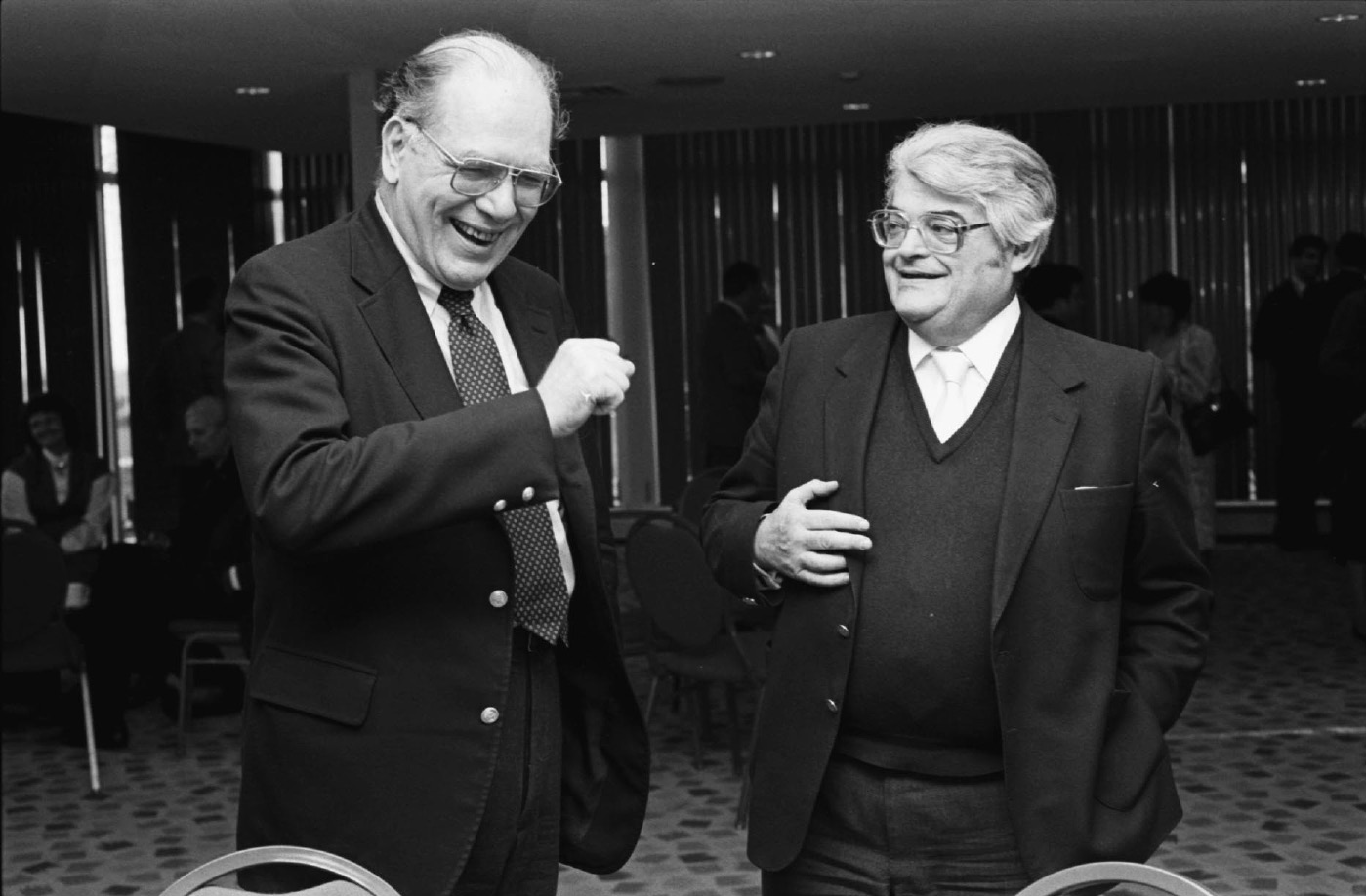 EIRNS/Philip Ulanowsky
Lyndon LaRouche and the late Norbert Brainin, the lead violinst of the legendary Amadeus Quartet, in December 1987.
|
When I was thinking of what I want to say tonight, I was reminded of a funny anecdote of Norbert Brainin, who was a great friend of Lyndon and Helga LaRouche. He was the first violinist of the famous Amadeus Quartet. And he was interviewed at one point, and the interviewer asked him, “Mr. Brainin, you’re the leader of the Amadeus Quartet, so I’d like to know, when your quartet is rehearsing and you come to a disagreement, are you the one that gets to decide what you do? Are you the one who makes the final call?”
And Brainin looked confused, and said, “Well, no. It’s not up to me. It’s up to the music. We learn from the music. We might disagree, but ultimately I’m not the one that makes the call. We have to find it in the music.”
And, in a very real sense, there is a right way to perform a piece of music. Not as a formula that could be written down, but there is a right, truthful performance to a piece of music, and it’s only found in the same kind of expression that we get in Kepler’s re-creation process in the Solar System. And it’s only when a performor or musician can re-create the creative experience of the original composer, that we’re getting somewhere close.
Uniting Science and Art
Now, there are a couple of things I wanted to point out about the string quartet in particular. Number one, as opposed to the scientist—Kepler, in our example—a string quartet is four people, four different minds. And so I think it raises the question, where do you locate the imagination of the string quartet? In whose body do you place the mind? Clearly, you can’t, right? So, where does the creative process of the string quartet exist?
 EIRNS/Daniel Platt
“A string quartet is actually presented with the exact same challenge as a scientist. . . .” Here, the Dirichlet Quartet (Nancy Shavin, My-Hoa Steger, David Shavin, and Jean-Sebastian Tremblay) performs Mozart’s “Dissonance Quartet,” at the Schiller Institute conference.
|
And now consider the fact that it’s not just four people interacting with each other, but it’s four people interacting with the mind of the composer. And it’s four people interacting with all of you. And I think that the kind of experience that you get with this kind of performance of Classical music, is actually one of the most profound expressions of the mind of mankind, one of the most profound experiences that a human being can have.
This completely breaks the bounds of time, and it completely breaks the bounds of space.
And what I want to end with, is the thought that this really embodies—and I think what we have to be resolved of—is that this Classical culture, this dedication to the human creative process, to breaking away from what’s imposed on us by the current culture, that man is a beast; man is limited to his senses; man cannot change; that there is no such thing as perpetual progress. We have to be committed to throwing that culture out. We have to be committed to a true revival and renaissance of Classical culture, and to achieve a victory, to win the kind the policies that were discussed throughout the day, to stop the threat of war, to stop the financial collapse, to begin to build NAWAPA—and if you let your imagination work—the kind of future that this portends for us, I think that it’s not just that it will be accompanied by a Classical culture; I think that they’re inseparable.
And the kind of evolution that this organization, that our association, and hopefully all of you, are committed to bringing about for the human species, will necessarily finally unite science and art as the ultimate expression of what it means to be human.
Thank you.
1. See the LaRouche PAC Basement Team’s treatment of the Harmony of the World on the LaRouche PAC website.
2. Graphic representations can be found on the LaRouche PAC website.

